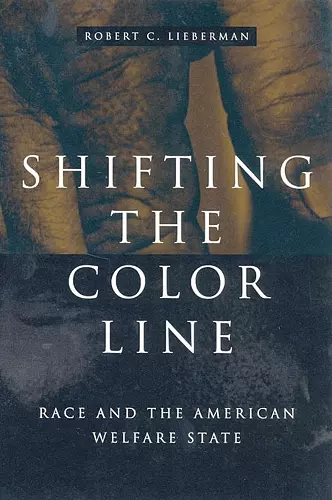Shifting the Color Line
Race and the American Welfare State
Format:Paperback
Publisher:Harvard University Press
Published:7th Oct '01
Currently unavailable, and unfortunately no date known when it will be back

Shifting the Color Line is one of the best studies of race and social policy that I have read. Lieberman's analysis of the role of race in the development of America's peculiar welfare state and, in turn, the role of the welfare state in reshaping the politics of race is a tour de force. -- William Julius Wilson, Harvard University This is a splendid book. Lieberman writes with confidence and verve. He makes real analytic progress on such crucial topics as the development of the American welfare state, contemporary debates about welfare and--most important--the interplay between welfare policies and race politics...Lieberman deploys the institutional model with enormous sophistication. He shows how a thoughtful historical approach can deepen our understanding of both American politics and public policy. -- James A. Morone, Brown University Shifting the Color Line is a giant leap forward in the analysis of American social policy, and will be recognized as an authoritative landmark for years to come. It is well-researched, well-written, and conceptually original and powerful. It will also be sure to excite controversy. -- Rick Valelly, Swarthmore College
Shifting the Color Line explores the historical and political roots of racial conflict in American welfare policy, beginning with the New Deal. Robert Lieberman demonstrates how racial distinctions were built into the very structure of the American welfare state.
Despite the substantial economic and political strides that African-Americans have made in this century, welfare remains an issue that sharply divides Americans by race. Shifting the Color Line explores the historical and political roots of enduring racial conflict in American welfare policy, beginning with the New Deal.
Through Social Security and other social insurance programs, white workers were successfully integrated into a strong national welfare state. At the same time, African-Americans--then as now disproportionately poor--were relegated to the margins of the welfare state, through decentralized, often racist, public assistance programs.
Over the next generation, these institutional differences had fateful consequences for African-Americans and their integration into American politics. Owing to its strong national structure, Social Security quickly became the closest thing we have to a universal, color-blind social program. On the other hand, public assistance--especially Aid to Families with Dependent Children (AFDC)--continued to treat African-Americans badly, while remaining politically weak and institutionally decentralized.
Racial distinctions were thus built into the very structure of the American welfare state. By keeping poor blacks at arm's length while embracing white workers, national welfare policy helped to construct the contemporary political divisions--middle-class versus poor, suburb versus city, and white versus black--that define the urban underclass.
A true understanding of welfare, Robert C. Lieberman argues in his provocative book, requires a hard look not at stereotypes but at history. Built into the early architecture of social welfare programs, are nasty political fights and rigged compromises over race and class. To make his point, Lieberman plays bureaucratic archeologist, unearthing and comparing the administrative structures of three social welfare programs: Old-Age Insurance, Aid to Dependent Children, and Unemployment Insurance… Shifting the Color Line is an enlightening look at America’s failure to ask, without racist or political motives, how poor people can make progress… The book is an intense history course that bypasses decades of deceptive rhetoric to get to the core issues of the welfare debate. -- Alyssa Haywoode * Boston Globe *
Robert Lieberman sets out to explain a ‘profound puzzle’ in the complicated history of race and the American welfare state… Lieberman combines historical and statistical analysis to show how and why… Clearly this book addresses issues of central importance to historians of race and social policy, and it does so with the kind of tightly argued thesis that is sure to stimulate further discussion and debate…he leaves us with important insights and evidence to build on in understanding the crucial, institutional dimensions of racial inequality. -- Alice O’Connor * Reviews in American History *
This is a splendid book. Lieberman writes with confidence and verve. He makes real analytic progress on such crucial topics as the development of the American welfare state, contemporary debates about welfare and—most important—the interplay between welfare policies and race politics… Lieberman deploys the institutional model with enormous sophistication. He shows how a thoughtful historical approach can deepen our understanding of both American politics and public policy. -- James A. Morone, Brown University
Shifting the Color Line is a giant leap forward in the analysis of American social policy, and will be recognized as an authoritative landmark for years to come. It is well-researched, well-written, and conceptually original and powerful. It will also be sure to excite controversy. -- Rick Valelly, Swarthmore College
Shifting the Color Line is one of the best studies of race and social policy that I have read. Lieberman’s analysis of the role of race in the development of America’s peculiar welfare state and, in turn, the role of the welfare state in reshaping the politics of race is a tour de force. -- William Julius Wilson, Harvard University
- Commended for Gustavus Myers Outstanding Book Award 1999
ISBN: 9780674007116
Dimensions: unknown
Weight: 467g
320 pages